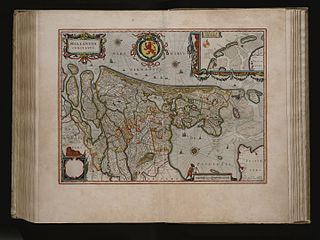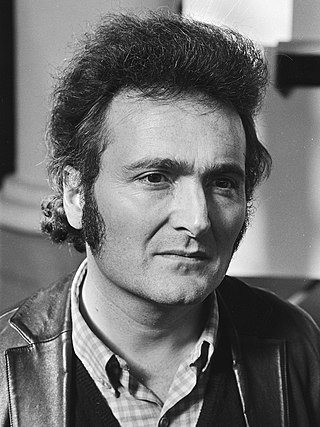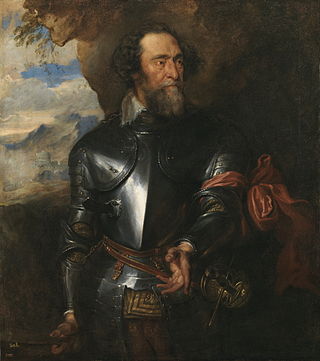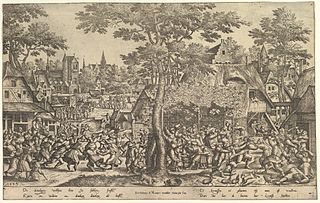Related Research Articles

The Atlas Maior is the final version of Joan Blaeu's atlas, published in Amsterdam between 1662 and 1672, in Latin, French, Dutch, German and Spanish, containing 594 maps and around 3,000 pages of text. It was the largest and most expensive book published in the seventeenth century. Earlier, much smaller versions, titled Theatrum Orbis Terrarum, sive, Atlas Novus, were published from 1634 onwards. Like Abraham Ortelius's Theatrum Orbis Terrarum (1570), the Atlas Maior is widely considered a masterpiece of the Golden Age of Dutch/Netherlandish cartography.

Johann Carolus was a German publisher of the first newspaper, called Relation aller Fürnemmen und gedenckwürdigen Historien. The Relation is recognised by the World Association of Newspapers, as well as many authors, as the world's first newspaper.

Nadere Reformatie is the period of church history in the Netherlands, following the Reformation, from roughly 1600 until 1750.
The International League of Antiquarian Booksellers is a non-profit umbrella organization of bookseller associations, with its legal location in Geneva, Switzerland. It federates 22 National Associations of Antiquarian Booksellers, representing nearly 2000 dealers in 32 countries. Antiquarian booksellers affiliated to the League adhere to the ILAB Code of Ethics, and the League aims to server as a global network for the rare book trade.

Herman Hertzberger is a Dutch architect, and a professor emeritus of the Delft University of Technology. In 2012 he received the Royal Gold Medal of the Royal Institute of British Architects.

The art of the Low Countries consists of painting, sculpture, architecture, printmaking, pottery, and other forms of visual art produced in the Low Countries, and since the 19th century in Belgium in the southern Netherlands and the Netherlands in the north.

Hendrik van den Bergh, 1573 to 22 May 1638, was a Flemish noble and professional soldier. Hereditary lord of Stevensweert, from 1618 to 1637 he was also stadtholder of Upper Guelders, the only part of Guelders to remain loyal to Habsburg Spain during the Eighty Years War. Known as a brave and resourceful cavalry commander, he spent most of his career with the Spanish Army of Flanders and became its Maestre de campo in 1628. Accused of treachery after the loss of Den Bosch in 1629, he defected to the Dutch Republic following the 1632 Conspiracy of Nobles.
Andrew David Mark Pettegree is a British historian and an expert on the European Reformation, the history of the book and media transformations. As of 2022 he holds a professorship at St Andrews University, where he is the director of the Universal Short Title Catalogue Project. He is the founding director of the St Andrews Reformation Studies Institute.
This is a timeline of philosophy in the 17th century.

Pieter van der Borcht (I) or Peter van der Borcht (c. 1530–1608) was a Flemish Renaissance painter, draughtsman and etcher. He is regarded as one of the most gifted botanical painters of the 16th century. Pieter van der Borcht the Elder also introduced new themes, such as the "monkey scene" (also called singerie) into Northern art.

Rutger Velpius was a 16th- and 17th-century printer and bookseller. He was the first printer in the city of Mons, and later became printer to the court in Brussels. His career coincided closely with the first decades of the Dutch Revolt
As of 2018, five firms in France rank among the world's biggest publishers of books in terms of revenue: Éditions Lefebvre Sarrut, Groupe Albin Michel, Groupe Madrigall, Hachette Livre, and Martinière Groupe.

As of 2018, Wolters Kluwer ranks as the Dutch biggest publisher of books in terms of revenue. Other notable Dutch houses include Brill and Elsevier.

The Spuistraat in downtown Amsterdam connects the Hekelveld to the Spui. It runs roughly north to south, parallel to the Singel and the Nieuwezijds Voorburgwal. At the Royal Palace of Amsterdam, the Spuistraat crosses the Raadhuisstraat and Paleisstraat. Originally the Spuistraat was a canal, the Nieuwezijds Achterburgwal. The canal was filled up in 1867, and the street was then renamed.
Pieter Perret was a Flemish engraver who worked in Madrid in the service of Philip II of Spain.
Harry Bekkering is a Dutch cultural scientist. He is an author and an associate professor at the Katholieke Universiteit Nijmegen.
Günter Gerhard Schilder, is a Dutch leading historian of cartography and for many years held the world's only chair in the history of cartography at the Utrecht University from 1981 to 2004.
References
- ↑ "Universal Short Title Catalogue Project Team" . Retrieved 7 July 2021.
- ↑ "List of RHS Fellows" . Retrieved 7 July 2021.
- ↑ Raymond, Joad (2018). "Dutch and Flemish Newspapers of the Seventeenth Century, 1618–1700. Arthur der Weduwen. 2 vols. Library of the Written Word 58; The Handpress World 43. Leiden: Brill, 2017. $403". Renaissance Quarterly . 71 (3). Cambridge University Press: 1120–1122. doi:10.1086/700483. S2CID 165194088 . Retrieved 7 July 2021.
- ↑ "The Golden Compass". 97. Antwerp Bibliophile Society. 2019: 71–72. Retrieved 7 July 2021.
{{cite journal}}: Cite journal requires|journal=(help) - ↑ "Menno Hertzberger Prizes 2019" . Retrieved 7 July 2021.
- ↑ "Leiden University Book Presentation". 2019. Retrieved 7 July 2021.
- ↑ van Stipriaan, René (30 October 2019). "How Amsterdam Became the Bookshop of the World". The Low Countries. Archived from the original on 6 May 2020. Retrieved 8 July 2021.
- ↑ "Basic Books" . Retrieved 7 July 2021.